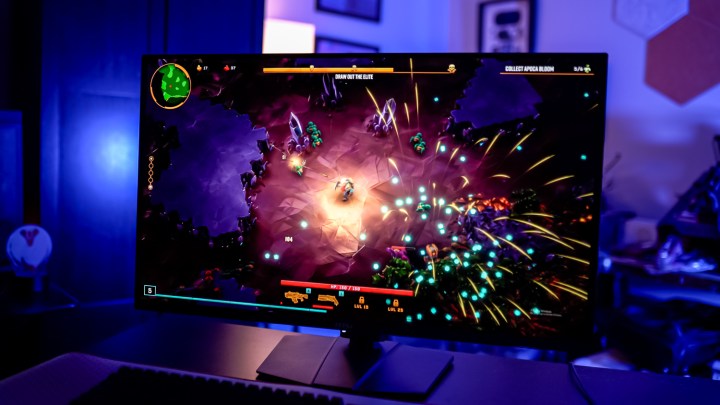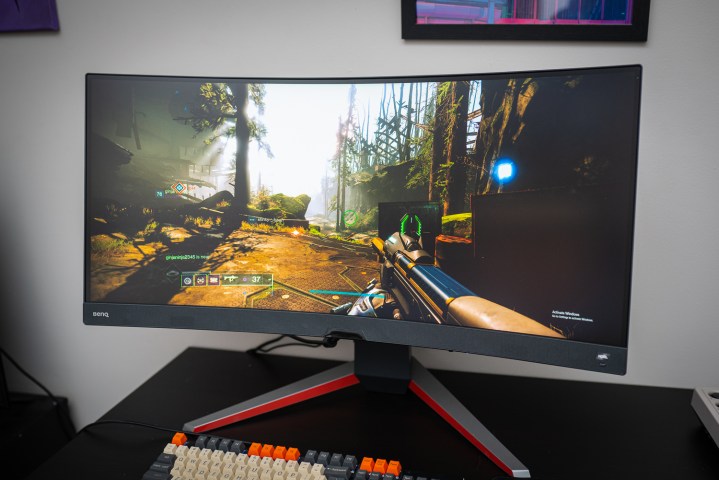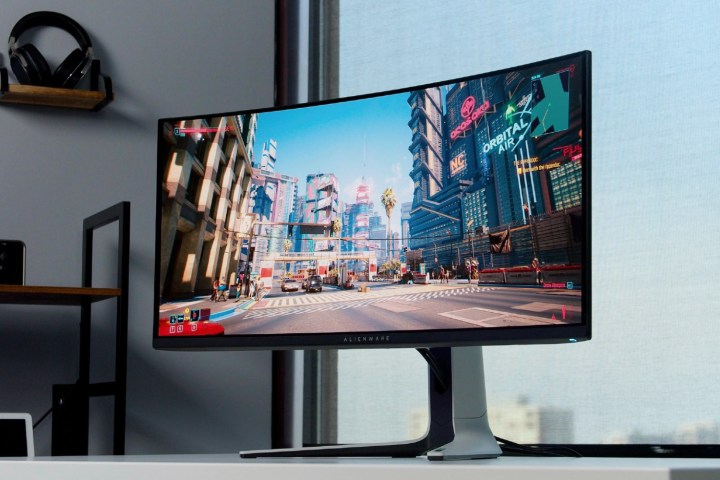
The Alienware 34 QD-OLED is one of the best gaming monitors you can buy. There’s no doubt about that. It has exceptional image quality, an attractive price, and a suite of features that are actually useful. Even with such high praise, the Alienware 34 QD-OLED isn’t for everyone, and there are some other great options available.
Maybe you’re looking to spend a little more or a little less, or maybe the ultrawide form factor isn’t for you. Regardless, we’ve rounded up four monitors that Digital Trends has reviewed and found to be great alternatives to the Alienware 34 QD-OLED.
Samsung Odyssey OLED G8

The most obvious alternative to the Alienware 34 QD-OLED is the Samsung Odyssey OLED G8. Both use the same Samsung Display QD-OLED panel, and you’re getting very similar performance out of the two monitors. Samsung’s version is slightly more expensive depending on sales, but it comes with some clear upsides.
The most obvious advantage is USB-C with power delivery. Samsung packs in a USB-C input that’s capable of 65 watts of power delivery. You can’t leverage it too much given that the monitor lacks an integrated USB hub and KVM switch, but it’s still an input method that Alienware doesn’t offer on its display.
In addition, the Odyssey OLED G8 is connected to the internet. It’s basically a smart TV, packing in Samsung’s Tizen operating system, a suite of apps, Bluetooth, and even wireless firmware updates via the Wi-Fi connection. You’ll mainly use the monitor with your PC, sure, but the inclusion of Bluetooth, Wi-Fi, and a few extra apps definitely gives Samsung’s monitor an edge.
The design is great, too. Alienware’s monitor looks fantastic, but it’s hard to beat the sleek aluminum frame and CoreSync lighting of the Odyssey OLED G8. If that kind of thing makes a difference to you, the Odyssey OLED G8 is definitely worth the premium.
MSI MPG 321URX QD-OLED

The MSI MPG 321URX solves the two biggest issues with the Alienware 34 QD-OLED. Alienware’s monitor uses older QD-OLED tech, which presents with issues with text clarity, and it’s not 4K, which is something you probably want if you’re dropping close to $1,000 on a monitor. The MSI MPG 321URX not only has a third-gen QD-OLED panel, but it also comes with a 4K resolution and 240Hz refresh rate.
This represents the peak gaming experience for most PC gamers, and we’ve seen versions from Asus and even Alienware itself. The main problem with those two monitors is that they’re much more expensive than the Alienware 34 QD-OLED. At $950, the MPG 321URX is slightly more expensive than the Alienware 34 QD-OLED when the latter is on sale, and even a little cheaper when it’s at full price.
There’s a lot of upside here, too. MSI’s monitor comes with 90W of USB-C power delivery and a KVM switch, allowing you to use your peripherals across multiple sources. Unfortunately, the USB ports are only up to the 2.0 spec, so you can’t use high-bandwidth devices like an external hard drive.
BenQ Mobiuz EX3410R

You want the Alienware 34 QD-OLED, but it’s just too expensive. That’s where the BenQ Mobiuz EX3410R comes into play. It gives you ultrawide resolution at 34 inches, a speedy 144Hz refresh rate, and decent image quality. The biggest difference is that this monitor comes in at less than half the price of the Alienware at $450.
I won’t pretend the Alienware 34 QD-OLED and BenQ Mobiuz EX3410R are in the same class. They’re not. Alienware’s display has much better HDR performance thanks to its QD-OLED panel and the refresh rate is faster. If you can spend up for Alienware’s monitor, it’s worth the price.
However, the BenQ Mobiuz EX3410R is still a solid monitor in its own right. The VA panel has solid color accuracy and covers a wide gamut, though the brightness is a bit low compared to OLED options. HDR performance isn’t great either, with only a DisplayHDR 400 rating. BenQ’s offering is much better than the competition in this same class due to its HDRi feature, however.
Cooler Master Tempest GP27Q

If you want a great HDR experience, but can’t afford the Alienware 34 QD-OLED, the Cooler Master Tempest GP27Q is for you. It’s a mini-LED display that comes in at $550 and boasts 576 local dimming zones. It’s doesn’t quite reach the HDR heights of the Alienware 34 QD-OLED, but it gets close enough considering how much cheaper Cooler Master’s monitor is.
There are a few other key differences. For starters, this is a 16:9 monitor with a 1440p resolution. Cooler Master sells a 4K version (the GP27U) that’s slightly more expensive. Cooler Master also packs in a USB-C input with up to 90W of power delivery, and it comes with higher peak brightness at 1,200 nits with HDR.
Cooler Master can match Alienware in other areas. The GP27Q has a 165Hz refresh rate, which is on par with the Alienware 34 QD-OLED, and it’s very color accurate. That’s due in no small part to the IPS panel, which gets much brighter due to the mini-LED backlight.
The GP27Q gets close to the experience of the Aliewnare 34 QD-OLED, just for hundreds of dollars less. It’s a great monitor by all accounts, though you’ll need to sacrifice the ultrawide wings if you go with it.
Best for a reason

The Alienware 34 QD-OLED has become the crown jewel of gaming monitors for a reason — it’s damn good. The price is right, the performance is unmatched, and the set of features is enough to satisfy more PC gamers.
That doesn’t mean you shouldn’t look on the monitor menu, however. There are some other fantastic options, and they may suit your needs better. Even after owning the Alienware 34 QD-OLED, I ended up selling it for a completely different display — maybe you’ll find yourself in a similar situation.




